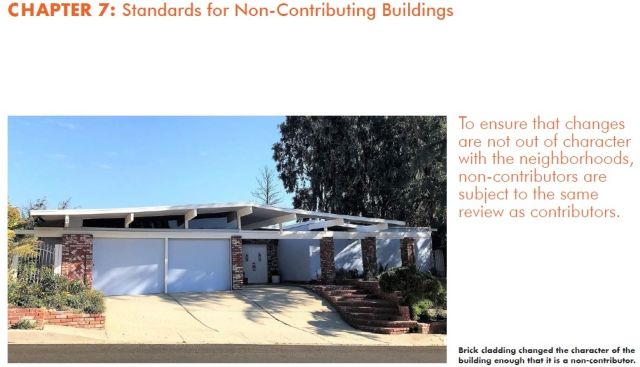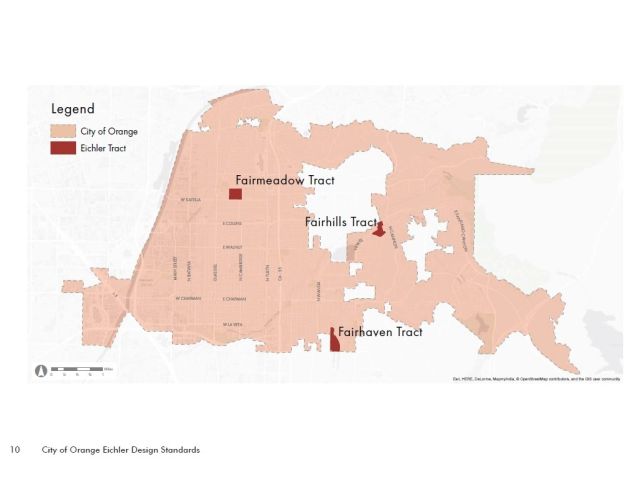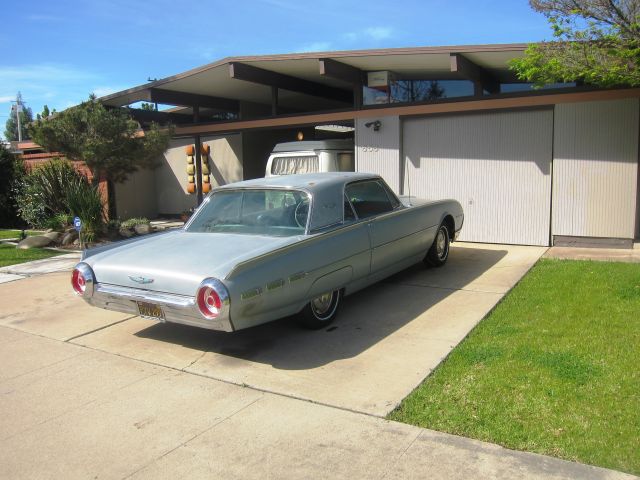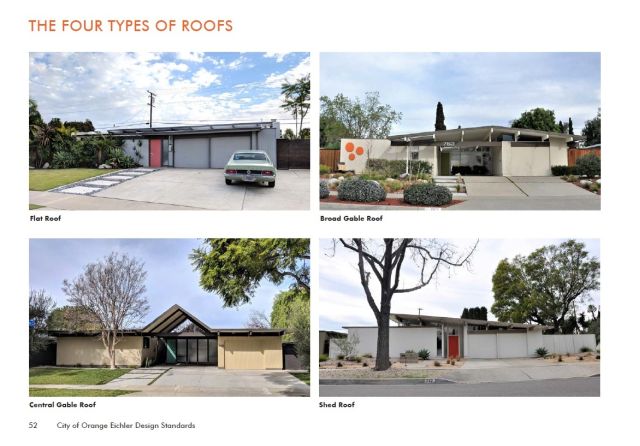
Strong Guidelines Seem to Win Support
 |
|
|
Oftentimes when governments propose strong regulations on what people can or cannot do, people object. But in the Southern California city of Orange, the people there who live in glass houses seem to be welcoming rules that will tell them not just what they should do with their homes, but what they shall do with them.
But maybe that’s because, in this case, efforts to preserve the Eichler homes of Orange arose from the ground up, with neighbors seeking the protection that can be offered by architectural guidelines backed up by planning department enforcement.
The comment period is closing soon on the draft version of the Orange Eichler Design Standards, and comments have generally been positive. The guidelines would be imposed as the tracts are named local historic districts.
Efforts are also underway to place the tracts on the National Register of Historic Places, which would be an honor, but would not provide the regulatory protection that comes with local designation.
 |
|
|
The three Orange Eichler tracts, with 339 homes total, are extremely well-preserved neighborhoods, so it makes sense people would want to protect what they’ve so ardently cared for. The tracts are Fairhaven (1960), Fairmeadow (1962), and Fairhills (1964).
Unlike some guidelines for Eichlers, like those recently adopted in Palo Alto, these do have restrictive rules. They are not, in some cases, mere suggestions.
More than once the document includes this useful definition of its terminology, including "Shall = required (standard)," and "Should = recommended (guideline)."
They also define: "Appropriate = acceptable, likely approved," and "Not appropriate = not acceptable, likely not approved."
The goal of the guidelines, the document states, is to “support the historic district designation by providing rules and guidelines on how best to preserve those features while allowing for change that is in keeping with the aesthetics of Eichler designs.
 |
|
|
“The goal is to balance predictability with flexibility so the distinctive character of the Eichler neighborhoods will continue.”
OK, so if you live in an Orange Eichler, and these guidelines are adopted as written, how would you be affected?
All but minor changes to facades that are visible from streets or sidewalks will require planning approval, though some approval can come by conferring with city staff.
“Changes to the interior of the buildings, including inside the atrium, are generally not reviewed under the Orange Eichler Design Standards, unless they are visible from the street,” the guidelines state.
Think twice about covering your atrium, though: “Enclosure of the atrium roof opening is discouraged.”
Also, “Atrium covers that rise slightly above the original roof level may be appropriate, as long as they do not substantially alter the roof form and are not highly visible from street views.”
 |
|
|
You’ll need to preserve your carport. Notice use of the word 'shall':
“Carports shall be preserved in place.”
Original roofing material doesn’t need to be preserved or replicated. But here comes another shall: “Replacement roofing materials shall be consistent with the plain appearance of the original, and not distract from the design of the residence.”
Sliding-glass doors a little flimsy? Think long and hard before modernizing!
“The repair and maintenance of the original sliding-glass doors is essential, as replacement doors that authentically replicate the originals are not commercially available,” the document explains. “Contemporary manufacturing techniques, coupled with the common use of dual-pane glazing, result in door frames with much broader profiles.”
There is much else on the aluminum sliding-door subject, but it is cast as a should. The tone suggests, though, that planners will strongly discourage any sliders that don’t look a lot like the originals.
The guidelines are worth reading even if you live in an Eichler or mid-century modern neighborhood outside of Orange. For one thing, if you are lucky, someday a similar document may be prepared for your neighborhood.
 |
|
|
And if you are simply interested in modern architecture, well, the document is simply a good read.
It is copiously illustrated, and clearly written. In fact, it strives to be painstakingly clear. The document stretches to 167 pages, and encompasses a short history of Eichler homes, brief professional bios of Joe Eichler’s architects, photos and floor plans of every model among the 339 Eichlers in town, along with names of the architects behind each.
The folks behind this document from the firm Page & Turnbill deserve credit, and they include John Lesak, principal; Flora Chou, project manager and cultural resources planner; Hannah Simonson, architectural historian and cultural resources planner; Troy Raisanen, designer; Julie Acosta, graphic designer; and Robert Imboden, who prepared a National Register of Historic Places nomination for the three tracts.
The guidelines will go through several more public meetings and levels of review before they are revised and adopted.
The guidelines and rules of the historic district would not require anyone who lives in a home that fails to 'contribute' to the district because of inappropriate changes to remove those changes.
But that is clearly encouraged.
As the document says, “For the most part, the Orange Eichler tracts have high integrity with an impressive majority of contributing houses. Most of the inappropriate alterations found among the non-contributors are reversible, affording opportunities for the properties to be restored and become district contributors.”
- ‹ previous
- 544 of 677
- next ›



